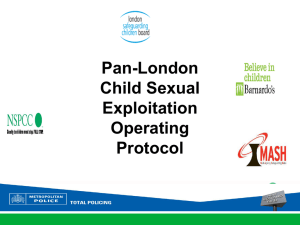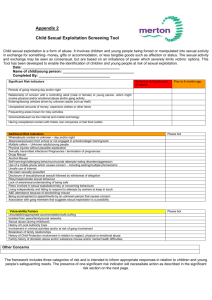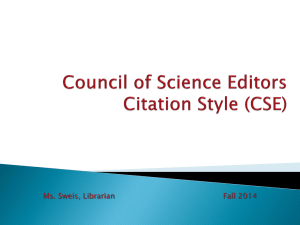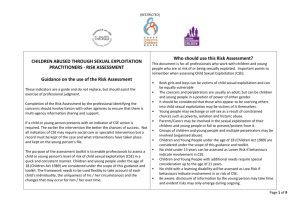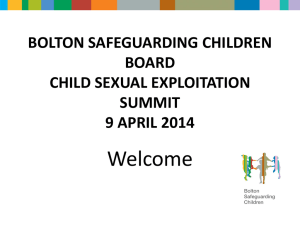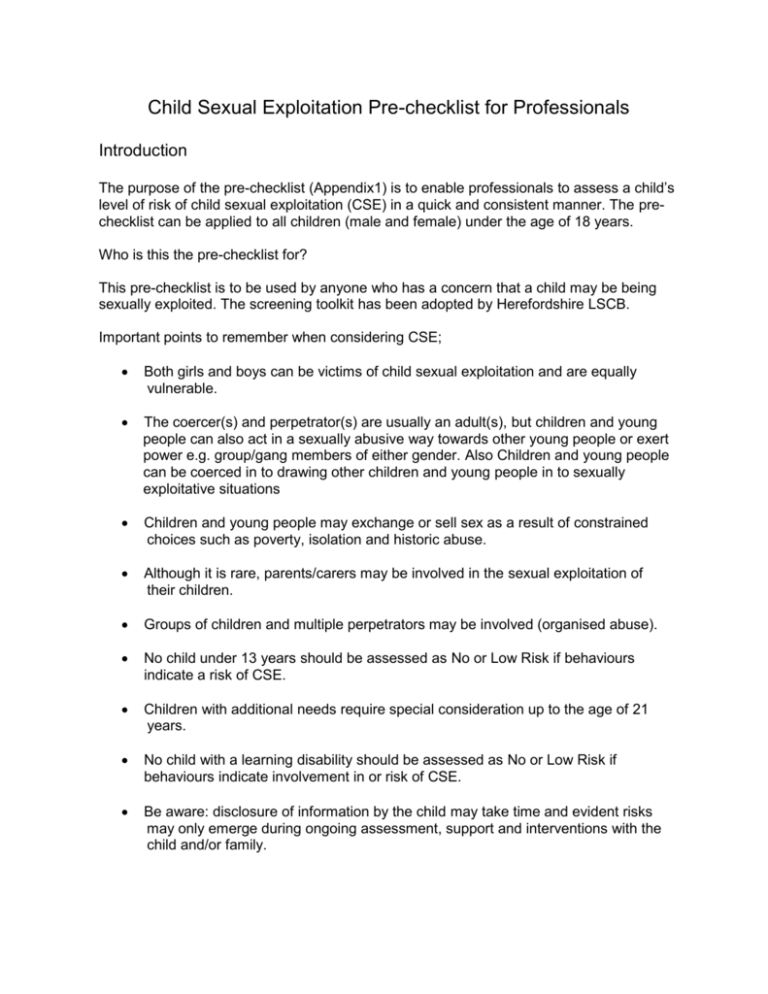
Child Sexual Exploitation Pre-checklist for Professionals
Introduction
The purpose of the pre-checklist (Appendix1) is to enable professionals to assess a child’s
level of risk of child sexual exploitation (CSE) in a quick and consistent manner. The prechecklist can be applied to all children (male and female) under the age of 18 years.
Who is this the pre-checklist for?
This pre-checklist is to be used by anyone who has a concern that a child may be being
sexually exploited. The screening toolkit has been adopted by Herefordshire LSCB.
Important points to remember when considering CSE;
Both girls and boys can be victims of child sexual exploitation and are equally
vulnerable.
The coercer(s) and perpetrator(s) are usually an adult(s), but children and young
people can also act in a sexually abusive way towards other young people or exert
power e.g. group/gang members of either gender. Also Children and young people
can be coerced in to drawing other children and young people in to sexually
exploitative situations
Children and young people may exchange or sell sex as a result of constrained
choices such as poverty, isolation and historic abuse.
Although it is rare, parents/carers may be involved in the sexual exploitation of
their children.
Groups of children and multiple perpetrators may be involved (organised abuse).
No child under 13 years should be assessed as No or Low Risk if behaviours
indicate a risk of CSE.
Children with additional needs require special consideration up to the age of 21
years.
No child with a learning disability should be assessed as No or Low Risk if
behaviours indicate involvement in or risk of CSE.
Be aware: disclosure of information by the child may take time and evident risks
may only emerge during ongoing assessment, support and interventions with the
child and/or family.
Guidance on the use of the screening tool
1. Completion of the pre-checklist: (Appendix 1) by the professional identifying the
concerns should involve liaison with other agencies to ensure that there is multiagency information sharing and support. The checklist should also be used as a
means of discussing and sharing your concerns about possible CSE with your line
manage/ designated lead, and considering next steps.
2. The pre-checklist is intended to assist the exercise of professional judgment by
assisting professionals to consider the risk of harm to a child. Professionals are
encouraged to go beyond the child’s presenting behaviour e.g. missing episodes
and to explore what else might be going on for this child/young person.
3. If a child presents with one indicator, action is required. Early intervention
improves the chances of positive outcomes. One indicator is unlikely to require
Children’s Social Work Services or specialist services intervention unless it is a
Significant Risk category.
4. Assessing or screening for child sexual exploitation should not be seen as a one off
event. Young people can move very quickly between the risk categories, therefore
regular assessment should be undertaken using the pre-checklist tool (Appendix 1).
Any escalation of risk should be dealt with in accordance with LSCB procedures.
5. Where risk is assessed as ‘medium’ or ‘significant’, then a referral must be made to
Children’s Social Work Services (MASH) or the allocated Social Worker where the
Child is already known.
6. The level of intervention required depends on the assessed level of risk.
Herefordshire LSCB procedures set out the pathways to be followed dependent on
the level of assessed risk including how to ensure information about the young
person is recorded by the LSCB at a local level. A summary can be found at
Appendix 1a.
7. Disruption and prosecution of perpetrator/s is also of significant importance
therefore, any information which comes to light about the victim/s or
perpetrator/s (however insignificant this may seem) should be passed on to the
Police via Information Report Forms.
8. The Child Sexual Exploitation Officer (CSE) should be informed of any young
person who is assessed as at risk of CSE.
Child Sexual Exploitation Pre-checklist for Professionals
Child sexual exploitation is a form of abuse. It involves children being forced or manipulated into sexual
activity in exchange for something- money, gifts or accommodation, or less tangible goods such as affection
or status. The sexual activity and exchange may be seen as consensual, but is based on an imbalance of
power which severely limits victims’ options. This Tool has been developed to enable the identification of
children and young people at risk of sexual exploitation.
Name of child/youngperson:____________________________________________________
Significant Risk Indicators
Current or during
the past 6 months:
Prior to 6
months
ago:
Periods of absence/missing (day and/or night)
Relationship of concern with a controlling adult (male or female) or young person,
which might involve physical and/or emotional abuse and/or gang activity
Entering/leaving vehicles driven by unknown adults (not car theft)
Unexplained amounts of money, expensive clothes or other items
Frequenting areas known for risky activities
Groomed/abused via the Internet and mobile technology
Having unexplained contact with hotels, taxi companies or fast food outlets
Risk Indicators
Whereabouts unclear or unknown – day and/or night
Absences/exclusion from school or not engaged in school/college/ training/work
Regular/Multiple contacts from unknown adults/young people
Physical injuries without plausible explanation
Sexually transmitted infections/ Pregnancies / termination of pregnancies
Drugs Misuse
Alcohol Misuse
Self-harming/challenging behaviours/suicide attempts/ eating disorders/aggression
Use of a mobile phone which causes concern – including sexting/multiple phones/sims
Unsafe use of internet
Has been sexually assaulted
Disclosure of sexual/physical assault followed by withdrawal of allegation
Risky/inappropriate sexual behaviour
Lack of awareness/understanding of being safe
Peers involved in sexual exploitation/risky or concerning behaviours
Living independently and failing to respond to attempts by workers to keep in touch
A&E attendance because of alcohol/drug misuse
Being accompanied to appointments by an unknown person that causes concern
Association with gang members that suggests sexual exploitation is a possibility
Vulnerability Factors
Unsuitable/inappropriate accommodation/sofa surfing/financially unsupported/migrant/refugee
Isolated from peers/family/social networks
Learning disabilities/special needs or mental health issues
History of Local Authority Care
Involvement in criminal activities and/or at risk of gang involvement
Family conflict/ breakdown, lack of love/security, death, loss, illness of a significant person in child’s life
History of Child Protection involvement in relation to neglect, physical sexual or emotional abuse
Family history of domestic abuse and/or substance misuse and/or mental health difficulties
Please tick
Please tick
The framework includes three categories of risk and is intended to inform appropriate responses in relation to
children and young people’s safeguarding needs. The presence of one significant risk indicator will necessitate
action as set out in LSCB procedures. Please use your professional judgement to reflect upon the indicators you
have ticked above and consider the health, welfare and safety of the child in question. (NB: A ‘child’ is any person
under the age of 18, male and female and older children can be equally as vulnerable)
Description
Associated actions
No/Low risk
A child who is at risk of being
groomed for sexual exploitation.
Liaise with Agency Designated Safeguarding Advisor for any advice/guidance.
Inform CSE Officer of young person considered at risk of CSE (so information
about the extent and profile of CSE is captured by LSCB).
Work with child, young person and family to develop an awareness of the risks
that can lead to a situation in which they may be exposed to sexual exploitation delivered on a single agency basis or integrated into existing multi-agency plan. .
Ongoing review of risk required particularly if there are any changes in
circumstances.
(1) A multi-agency approach will be needed to promote child’s safety and wellbeing.
(2) Follow local procedures including referral to Children’s Social Work Services
who will lead the completion of a specialist CSE Risk Assessment on a multiagency basis. A multi-agency child sexual exploitation meeting should be held to
devise a safeguarding and support plan or such activity should be integrated into
an existing multi-agency plan. The plan should include actions in relation to
disrupting, investigating and prosecuting perpetrators. Risk should be closely
monitored and regularly assessed as part of the risk management process.
(3) Inform CSE Coordinator of young person considered at risk of CSE (so
information about the extent and profile of CSE is captured by LSCB).
(1) A multi-agency approach will be needed to promote child’s safety and wellbeing.
(2) Follow local procedures including referral to Children’s Social Work Services
who will lead the completion of a specialist CSE Risk Assessment on a multiagency basis. A multi-agency child sexual exploitation meeting should be held to
devise a safeguarding and support plan or such activity should be integrated into
an existing multi-agency plan. The plan should include actions in relation to
disrupting, investigating and prosecuting perpetrators. Risk should be closely
monitored and regularly assessed as part of the risk management process.
(3) Inform CSE Coordinator of young person considered at risk of CSE (so
information about the extent and profile of CSE is captured by LSCB).
Medium risk
A child who is targeted for abuse
through exchange of sex for
affection, drugs, accommodation
and goods etc.
The likelihood of coercion and
control is significant
Significant risk
A child who is entrenched in sexual
exploitation, but often does not
recognise or self denies the nature
of their abuse often in denial, and
where coercion/control is implicit.
Where to refer or discuss your concerns:
Anyone who completes a CSE screening tool, or is considering the need to do so, can seek advice from the
Designated Safeguarding Advisor in their agency/service/setting
Advice can also be sought from the CSE Officer, Amy Proctor, tel. 01432 260552
If the screening tool indicates that the child/young person is likely to be at medium or significant risk of sexual
exploitation you should contact Children’s Social Care or the Police:
Children’s Social Work Services: Multi Agency Safeguarding Hub (MASH)
01432 260800
Emergency Duty Team (EDT) (out of hours)
01905 768020
Police:
Central Referral Unit
0300 333 3000
Emergency
999
Where to get more information:
Child Exploitation and Online Protection (CEOP) www.thinkuknow.co.uk
PACE – Parents Against Child Sexual Exploitation. www.paceuk.info
UKHTC – UK Human Trafficking Centre. www.soca.gov.uk/about-soca/about-the-ukhtc
Herefordshire LSCB Procedures:
http://westmerciaconsortium.proceduresonline.com/chapters/p_safeguard_child_and_young.html
CSE Pathway Guidance
Appendix 1A
If there are immediate safeguarding concerns, Herefordshire LSCB procedures are to be followed
http://hscb.herefordshire.gov.uk/the-board-and-our-priorities/worried-about-a-child/
CSE Officer –Amy Proctor
Tel – 01432 260552 Email –
amy.proctor@herefordshire.gov.uk
Where there are concerns about the possibility of a child being at risk of Child Sexual Exploitation, complete the CHILD SEXUAL EXPLOITATION
Pre-checklist for professionals and seek support from your safeguarding lead and/ or CSE Senior Practitioner
No/Low Risk
Case management may not be with
children’s social care .
Notify CSE Officer of screening
outcome, including a copy of CSE Screening
Tool, for inclusion on CSE database.
There should be either a single agency
diversion plan to support the young person,
or a professionals meeting of the agencies
currently in contact with the child/ young
person should be called to discuss risks, and
develop a diversion plan.
The diversion plan should consider…
Specific risk factors identified
Awareness raising work around healthy
relationships and CSE
Education/ training/ employment
support
Family Support
Any other relevant concerns
The meeting should be recorded, and the
diversion plan recorded using action
plan template
http://westmerciaconsortium.proceduresonline.com/
chapters/p_safeguard_child_and_young.html
Medium Risk
For cases not open to Social Care, or where you are unsure of Social
Care involvement, make a referral to MASH using the multi-agency
referral form, stating CSE Pre-checklist outcome and identified
concerns. Where you are aware of current social care involvement,
discuss your concerns with the allocated social worker.
Notify CSE Officer of referral or concerns, including a copy of CSE Prechecklist, for inclusion on CSE database.
Following Assessment by MASH confirming concerns, a Risk
Management meeting should be called to be chaired by the social work
manager.
Specialist CSE Risk Assessment to be completed prior to the meeting,
and safeguarding and diversion plan to be devised.
Procedures, including invitees and agenda, for Risk Management
Meetings can be found at
http://westmerciaconsortium.proceduresonline.com/chapters/p_safeguar
d_child_and_young.html
Risk Management Review meetings should be held within 15 days of
referral and plans reviewed every 3 months minimum, or following
significant change in circumstances or information shared
The disruption and investigation of offenders is an essential component
of a safeguarding and diversion plan.
A CSE Risk Assessment must be carried out
within this meeting, or by the single agency
responsible for the safeguarding and
diversion plan.
Referral should be made to MASH Team for direct work as part of the
safeguarding and diversion plan. In the event of a waiting list for this
support, healthy relationships and keep safe work should be carried out
by the most appropriate existing practitioner involved.
The single or multi-agency plan should be
undertaken ina timely way, and reviewed every 3
months minimum, or more regularly as risks
change.
-Keep records of incidents/indicators
-Monitor changes in vulnerability/risk
-Use Police Information Sharing Tool for information on victim and/or
perpetrator i.e. names, locations or other useful intelligence. Also inform
CSE Officer of this intelligence.
-Keep records of incidents/indicators
-Monitor changes in vulnerability/risk
-Use Police Information Sharing Tool for
information on victim and/or perpetrator i.e.
names, locations or other useful intelligence.
Also inform CSE Officer of this intelligence.
Resources which could be used to support
young people are…
-Healthy & Safe Relationships
-Barnardos BWise 2 Sexual Exploitation
Engage parents as they are likely to be a significant source of
information and evidence. Guidance on involving parents can be found
within LSCB CSE procedures in the link below)
Full LSCB procedures for Safeguarding Children and Young People
from CSE can be found at
http://westmerciaconsortium.proceduresonline.com/chapters/p_safeguar
d_child_and_young.html
Significant Risk
For cases not open to Social Care, or where you are unsure of
Social Care involvement, make a referral to MASH using the multiagency referral form, stating CSE Pre-checklist outcome and
identified concerns. Where you are aware of current social care
involvement, discuss your concerns with the allocated social
worker.
Notify CSE Officer of referral or concerns, including a copy of CSE
Pre-checklist, for inclusion on CSE database.
Following Assessment by MASH confirming concerns, a Risk
Management meeting should be called to be chaired by social work
manager.
Specialist CSE Risk Assessment to be completed within the Risk
Management Meeting, and safeguarding and diversion plan to be
devised. If the case is already open to social care, this should be
integrated into existing planning and review processes.
Procedures, including invitees and agenda for Risk Management
Meetings can be found at
http://westmerciaconsortium.proceduresonline.com/index.htm
Risk Management Review meetings should be held within 15 days
of referral and reviewed every 3 months minimum, or following
significant change in circumstances or information shared.
The disruption and investigation of offenders is an essential
component of a safeguarding and diversion plan.
Referral must be made to CSE Team for direct work as part of the
safeguarding and diversion plan. In the event of a waiting list for
this support, healthy relationships and keep safe work should be
carried out by the most appropriate existing practitioner involved.
-Keep records of incidents/indicators
-Monitor changes in vulnerability/risk
-Use Police Information Sharing Tool for information on victim
and/or perpetrator i.e. names, locations or other useful intelligence.
Also inform CSE Officer of this intelligence.
-Use key disruption tactics eg, Abduction Orders, Harbouring
Notices and licensing legislation.
-Consult with UK Human Trafficking Centre and/or UK Border
Agency where appropriate. Refer any case of human trafficking to
the NRM (National Referral Mechanism)
Engage parents as they are likely to be significant source of
information and evidence. Guidance on involving parents can be
found within LSCB CSE procedures in the link
below)http://westmerciaconsortium.proceduresonline.com/chapters/p_
safeguard_child_and_young.html



